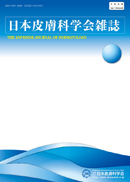All issues

Volume 118, Issue 5
Displaying 1-8 of 8 articles from this issue
- |<
- <
- 1
- >
- >|
Seminar for Medical Education
-
[in Japanese], [in Japanese]Article type: Seminar for Medical Education
2008 Volume 118 Issue 5 Pages 897-903
Published: April 20, 2008
Released on J-STAGE: December 03, 2014
JOURNAL RESTRICTED ACCESS -
[in Japanese]Article type: Seminar for Medical Education
2008 Volume 118 Issue 5 Pages 905-909
Published: April 20, 2008
Released on J-STAGE: December 03, 2014
JOURNAL RESTRICTED ACCESS -
[in Japanese]Article type: Seminar for Medical Education
2008 Volume 118 Issue 5 Pages 911-917
Published: April 20, 2008
Released on J-STAGE: December 03, 2014
JOURNAL RESTRICTED ACCESSDownload PDF (1254K)
Original Articles
-
Yasuhiro Ito, Shin Iinuma, Tuyoshi Iwasaki, Makoto Hashimoto, Akemi Is ...Article type: Original Articles
2008 Volume 118 Issue 5 Pages 919-923
Published: April 20, 2008
Released on J-STAGE: December 03, 2014
JOURNAL RESTRICTED ACCESSWe reviewed 98 malignant melanoma patients who underwent elective lymphadenectomy or sentinel node biopsy. The five year melanoma-specific survival rate was 95.5% among patients with tumor-negative nodes and 71.3% among those with tumor-positive nodes (p=0.01680). The five year melanoma-specific survival rate was 73.3% among patients with nodal micrometastases of sentinel node or elective lymphadenectomy, and 23.4% among those with nodal macrometastases (p=0.01920). Our results indicate that sentinel node biopsy provides important prognostic information and that patients with occult nodal micrometastases may be rescued by this procedure.View full abstractDownload PDF (479K) -
Takashi Hashimoto, Tomoko Tanaka, Kaoru Takayama, Takahiro Satoh, Hiro ...Article type: Original Articles
2008 Volume 118 Issue 5 Pages 925-931
Published: April 20, 2008
Released on J-STAGE: December 03, 2014
JOURNAL RESTRICTED ACCESSA 46-year-old female was referred for investigation of non-pitting edema of the hands and lower legs associated with eosinophilia. Based on laboratory findigs and histopathology of a skin biopsy, the patient was diagnosed as having non-episodic angioedema with eosinophilia. The patient’s symptoms improved without treatment within 12 weeks. The treatments used in 60 cases of non-episodic angioedema with eosinophilia reported from Japan were reviewed. The treatments included: (1) corticosteroids alone, (2) antihistamines or anti-allergic drugs alone, (3) antihistamines or anti-allergic drugs given with corticosteroids, and (4) no medication. On statistical analysis, corticosteroid treatment was effective in improving symptoms and in significantly reducing the duration required for remission. However there were no statistical differences in total disease duration or treatment duration required for obtaining improvement between patients treated with antihistamines or anti-allergic drugs and patients given no medications. Thus, it appears that antihistamines or anti-allergic drugs have no clinical benefits in the treatment of non-episodic angioedema with eosinophilia.View full abstractDownload PDF (967K) -
Satoru Shinkuma, Yukiko Tsuji-Abe, Yuki Tomita, Ken Natsuga, Hideyuki ...Article type: Original Articles
2008 Volume 118 Issue 5 Pages 933-937
Published: April 20, 2008
Released on J-STAGE: December 03, 2014
JOURNAL RESTRICTED ACCESSBullous pemphigoid is an autoimmune blistering disease in which patients produce autoantibodies to hemidesmosome-basement membrane zone components. Most bullous pemphigoid patients respond well to systemic corticosteroids, but additional therapies such as pulsed corticosteroid therapy or immunosuppressants are sometimes required in more refractory cases. Intravenous immunoglobulin treatments have been increasingly used to treat a range of autoimmune blistering diseases. In the literature, there are several dozen bullous pemphigoid cases which have been successfully treated with intravenous immunoglobulins. An 83-year-old Japanese female presented with widely disseminating edematous erythema, bullae, and erosions that developed over her entire body. Based upon the clinical, histological and immunohistological findings and BP180 ELISA test scores, she was diagnosed with bullous pemphigoid. She was initially treated with prednisolone (0.75 mg/kg/day), but she was resistant to the therapy. Because she also suffered from lung cancer and her general condition was poor, intravenous immunoglobulin therapy (2 g/kg) was performed, resulting in rapid improvement.View full abstractDownload PDF (1032K) -
Shin-ichi Ansai, Takaya Fukumoto, Tetsunori KimuraArticle type: Original Articles
2008 Volume 118 Issue 5 Pages 939-945
Published: April 20, 2008
Released on J-STAGE: December 03, 2014
JOURNAL RESTRICTED ACCESSWe reviewed and analysed histopathological diagnoses of 13,594 specimens, that had been clinically diagnosed as melanocytic nevus and histopathologically diagnosed in the Sapporo Institute for Dermatopathology. They included 3,497 specimens (5.7%) from male patients and 10,097 specimens (74.3%) from female patients. The lesions were most frequently located on the face (53.8%). Histopathologically, 11,840 specimens (87.1%) were diagnosed as melanocytic nevus. The cases not diagnosed as melanocytic nevus included 8.6% benign epithelial neoplasms, 2.4% benign non-epithelial neoplasms, and 1.3% malignant neoplasms. Among the malignant neoplasms, the most frequent (0.9%) diagnosis was basal cell carcinoma; 16 specimens (0.1%) were malignant melanoma in situ, and 13 cases (0.1%) were malignant melanoma. The concordance rate between clinical and histopathological diagnoses was high for the lesions on the lower limbs (92.3%) and the face (89.2%), although low for those on the neck (78.2%) and the trunk (79.1%). Malignant neoplasms were frequently located on the face and scalp. The median age at resection of the cases with melanocytic nevus (36.5±15.9 years) was significantly lower than those with another diagnosis (53.3±18.1 years). These data indicate that diagnoses should be confirmed histopathologically in lesions clinically diagnosed as benign melanocytic ones.View full abstractDownload PDF (624K)
Abstracts
-
2008 Volume 118 Issue 5 Pages 947-963
Published: 2008
Released on J-STAGE: December 03, 2014
JOURNAL RESTRICTED ACCESSDownload PDF (3099K)
- |<
- <
- 1
- >
- >|